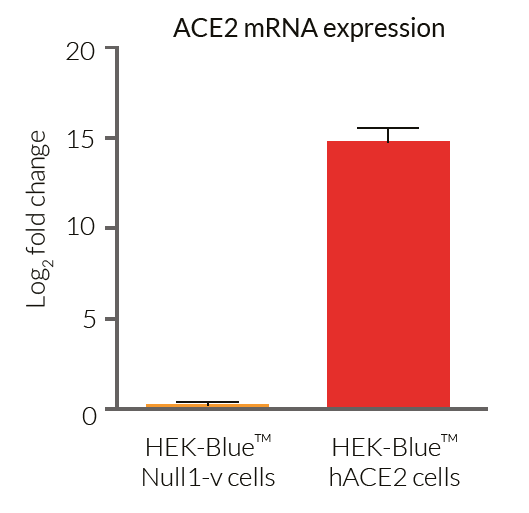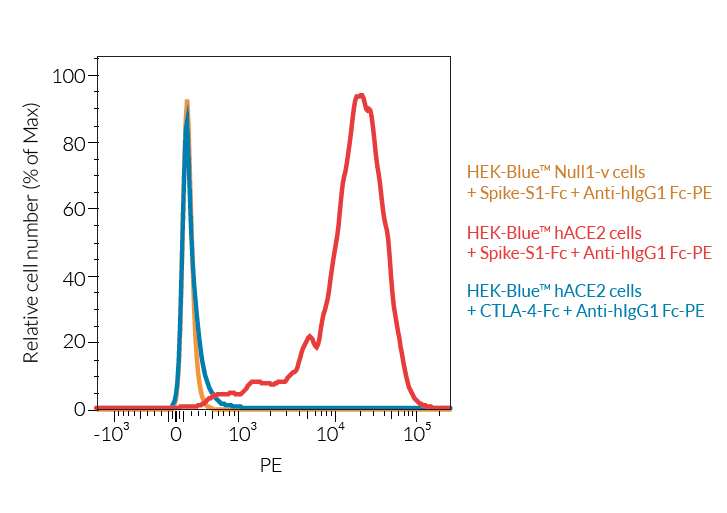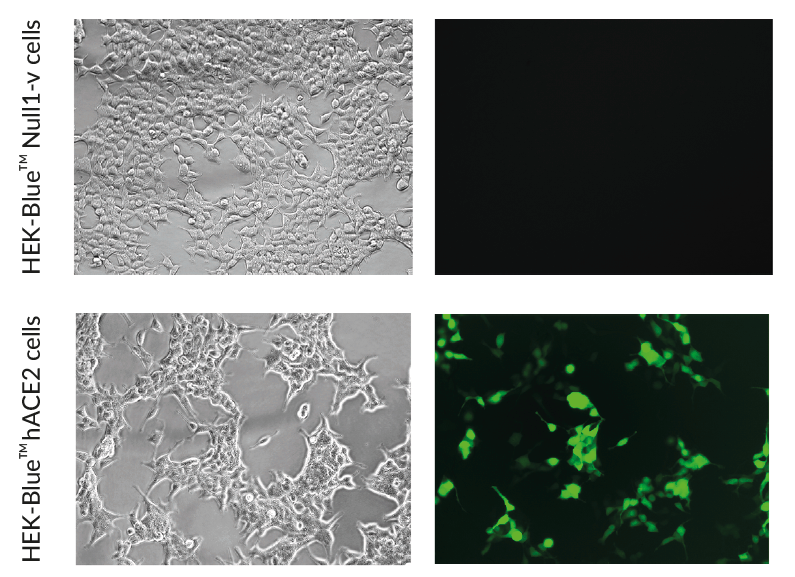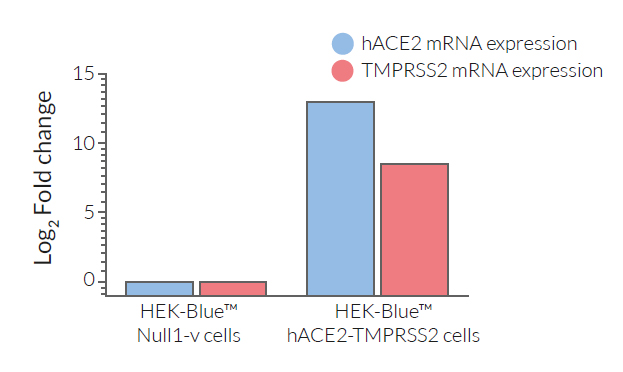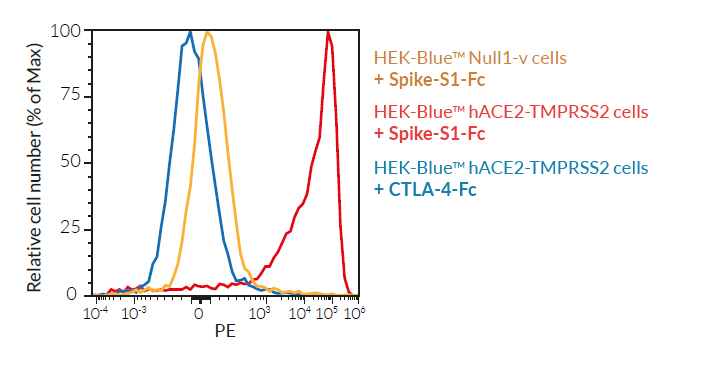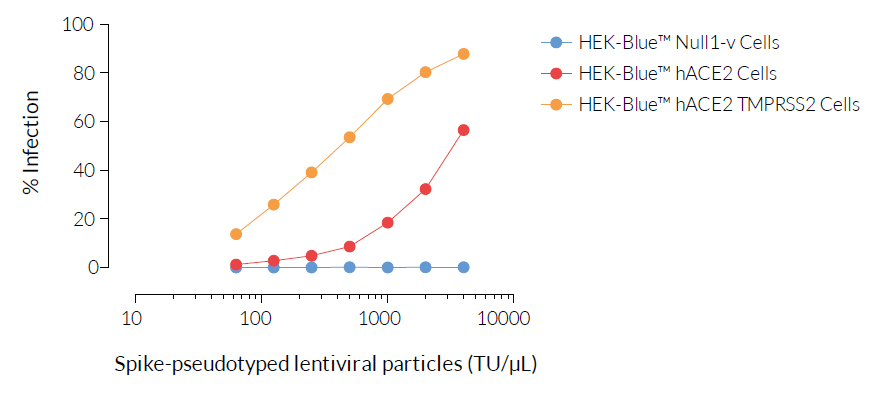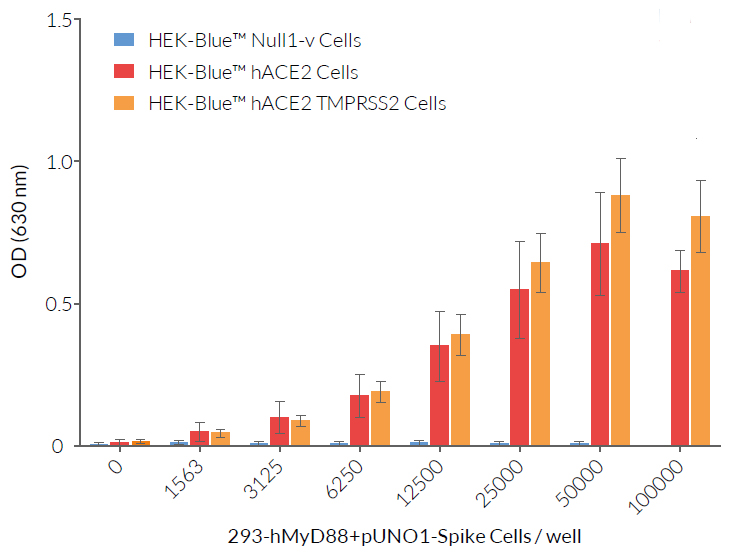Human ACE2 & TMPRSS2 expressing HEK293 Cells
| Product | Unit size | Cat. code | Docs. | Qty. | Price | |
|---|---|---|---|---|---|---|
|
HEK-Blue™ hACE2-TMPRSS2 Cells SEAP reporter HEK293 cells expressing human ACE2 and TMPRSS2a |
Show product |
3-7 x 10e6 cells |
hkb-hace2tpsa
|
|
||
|
HEK-Blue™ hACE2-TMPRSS2 vial Additional cell vial |
Show product |
3-7 x 10e6 cells |
hkb-hace2tpsa-av
|
|||
|
HEK-Blue™ hACE2 Cells SEAP reporter HEK293 cells expressing human ACE2 |
Show product |
3-7 x 10e6 cells |
hkb-hace2
|
|
||
|
HEK-Blue™ hACE2 vial Additional cell vial |
Show product |
3-7 x 10e6 cells |
hkb-hace2-av
|
Notification: Reference #hkb-hace2-av can only be ordered together with reference #hkb-hace2.
Reference #hkb-hace2tpsa-av can only be ordered together with reference #hkb-hace2tpsa.
HEK293 NF-κB-reporter cells expressing the SARS-CoV-2 receptors
InvivoGen offers human embryonic kidney 293 (HEK-293)-derived cell lines, specifically designed for COVID-19 studies:
— HEK-Blue™ hACE2-TMPRSS2 cells
— HEK-Blue™ hACE2 cells
These cells have been engineered to stably overexpress the host SARS-CoV-2 receptors, human (h)ACE2, and TMPRSS2 [1]. They were generated from HEK‑Blue™ Null1‑v cells, which express an NF-κB inducible SEAP (secreted embryonic alkaline phosphatase) reporter gene.
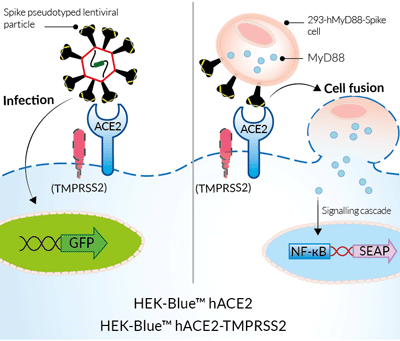
Studying infection and cell fusion with
HEK-Blue™ hACE2-TMPRSS2 cells
 Available upon request:
Available upon request:
• HEK-Lucia™ hACE2 Cells
• HEK-Lucia™ hACE2-TMPRSS2 Cells
• HEK-hACE2 Cells
• HEK-hACE2-TMPRSS2 Cells
Sensitive to SARS-CoV-2
SARS-CoV-2, the causative agent of coronavirus disease-19 (COVID-19), gains entry into host cells through the interaction of the viral Spike protein with the host ACE2 and TMPRSS2 receptors [1]. HEK293-derived cells are poorly permissive to infection by SARS-CoV-2 or Spike pseudotyped lentiviral particles. Therefore, to increase their permissivity HEK-Blue™ Null1-v cells have been stably transfected with ACE2 only, or ACE2 and TMPRSS2. In contrast to HEK-Blue™ Null1-v cells, HEK-Blue™ hACE2(‑TMPRSS2) cells are sensitive to Spike pseudotyped lentiviral particles. Notably, the addition of TMPRSS2 increases the cell line’s infectivity.
For studying Spike-ACE2-dependent cell fusion
These HEK-293-derived SARS-COV-2 permissive reporter cells can be used as ‘acceptor’ cells in InvivoGen’s SARS-CoV-2 Spike-ACE2 dependent cell fusion assay. This relies on the transfer of the TLR/IL-1 adaptor molecule, MyD88, from a 'donor cell line' (293-hMyD88 transfected with a Spike expression plasmid) to an 'acceptor cell line' expressing an NF-κB-SEAP-inducible reporter gene. Cell fusion is readily assessable in the co-culture supernatant using the SEAP detection reagent, QUANTI‑Blue™ Solution. Unlike infection by pseudotyped particles, the presence of TMPRSS2 does not have an effect on cell fusion in this assay.
Key features
- Verified overexpression of human ACE2 and TMPRSS2 genes
- Permissive and sensitive to SARS-COV-2 Spike pseudotyped lentiviral particles
- Functionally tested in InvivoGen’s cell fusion assay with SARS-CoV-2 Spike-expressing hMyD88 cells.
- Readily assessable NF-κB-dependent SEAP reporter activity
Applications
- Screening inhibitors of Spike-binding and/or its host receptors (i.e. ACE2 and TMPRSS2).
- Studying the efficacy of the vaccines and/or current therapeutics (e.g. mAbs) against the emerging variants by infection studies with pseudotyped particles or cell fusion assays.
InvivoGen has also generated:
➔ HEK-Lucia™ hACE2 and HEK-Lucia™ hACE2-TMPRSS2 cells featuring an NF-KB-inducible Lucia luciferase reporter for a larger detection range than the colorimetric SEAP assays.
➔ HEK-hACE2 and HEK-hACE2-TMPRSS2 cells with no reporter activity for infection, pseudoparticle transduction, or qualitative fusion assays.
These cells have been used to compare the efficiency of SARS-CoV2 Spike variant-mediated cellular infection and fusion. See data
![]() Learn more about SARS-CoV-2 infection and potential therapeutics
Learn more about SARS-CoV-2 infection and potential therapeutics
References
1. Hoffmann M. et al., 2020. SARS-CoV-2 cell entry depends on ACE2 and TMPRSS2 and is blocked by a clinically proven protease inhibitor. Cell. 181:1-16.
2. Zhou P. et al., 2020. A pneumonia outbreak associated with a new coronavirus of probable bat origin. Nature. 579(7798):270-273.
3. Walls A.C. et al., 2020. Structure, function, and antigenicity of the SARS-CoV-2 spike glycoprotein. Cell. 181(2):281-292.e6.
Specifications
Growth medium: DMEM, 4.5 g/L glucose, 2 mM L-glutamine, 10% (v/v) heat-inactivated fetal bovine serum (FBS), 100 U/ml penicillin, 100 µg/ml streptomycin, 100 µg/ml Normocin™
Antibiotic resistance:
- HEK-Blue™ hACE2-TMPRSS2: Hygromycin B Gold, Puromycin and Zeocin®
- HEK-Blue™ hACE2: Puromycin and Zeocin™
Quality Control
- ACE2 gene expression has been verified by RT-qPCR, FACS staining, and functional assays.
- TMPRSS2 gene expression has been verified by RT-qPCR and functional assays.
- Activation of the NF-κB response has been verified upon stimulation with various inducers (e.g. TNF-α).
- The stability for 20 passages, following thawing, has been verified for HEK-Blue™ hACE2 and HEK-Blue™ hACE2-TMPRSS2
- These cells are guaranteed mycoplasma-free.
Contents
Please note: Each cell line is sold separately. See TDS for the exact contents of each cell line.
HEK-Blue™ hACE2-TMPRSS2 cells
- 3-7 x 106 HEK-Blue™ hACE2-TMPRSS2 cells in a cryovial or shipping flask
- 1 ml of Puromycin (10 mg/ml)
- 1 ml of Hygromycin B Gold (100 mg/ml)
- 1 ml of Zeocin® (100 mg/ml)
- 1 ml of Normocin™ (50 mg/ml). Normocin™ is a formulation of three antibiotics active against mycoplasmas, bacteria, and fungi.
- 1 ml of QB reagent and 1 ml of QB buffer (sufficient to prepare 100 ml of QUANTI-Blue™ Solution, a SEAP detection reagent)
HEK-Blue™ hACE2 cells
- 3-7 x 106 HEK-Blue™ hACE2 cells in a cryovial or shipping flask
- 1 ml of Puromycin (10 mg/ml)
- 1 ml of Zeocin® (100 mg/ml)
- 1 ml of Normocin™ (50 mg/ml). Normocin™ is a formulation of three antibiotics active against mycoplasmas, bacteria, and fungi.
- 1 ml of QB reagent and 1 ml of QB buffer (sufficient to prepare 100 ml of QUANTI-Blue™ Solution, a SEAP detection reagent)
![]() Shipped on dry ice (Europe, USA, Canada and some areas in Asia)
Shipped on dry ice (Europe, USA, Canada and some areas in Asia)
Back to the top
Details
ACE2 and TMPRSS2 Background
ACE2 (angiotensin I-converting enzyme-2) and TMPRSS2 (transmembrane protease serine 2) play a critical role in the pathogenesis of COVID-19 by allowing viral entry into target cells. ACE2 and TMPRSS2 are cell-surface proteins that both interact with the virus Spike (S) protein [1-3]. ACE2 is mandatory for the binding of SARS-CoV-2 at the cell surface through its interaction with the Spike receptor-binding domain (RBD) [4]. Following this, TMPRSS2 cleaves the S protein into two functional subunits (S1 and S2), allowing virus-host membrane fusion, and the release of viral contents (e.g. RNA) into the cytosol [3-5]. Another protease, the Cathepsin L, also mediates cleavage of the S protein but it acts in the endosomes. Camostat is a clinically proven inhibitor of TMPRSS2 and has been shown to inhibit SARS-CoV-2-S pseudotyped viral particles entry into primary human lung cells in a dose-dependent manner [2]. This observation demonstrates the critical implication of TMPRSS2 in SARS-CoV-2 infection and spread. Moreover, in lung cells that fail to express robust levels of Cathepsin L, the virus entry depends on a furin-mediated pre-cleavage of the S protein at the S1/S2 site, before subsequent TMPRSS2-mediated cleavage at the S2' site [6]. Notably, TMPRSS2 may not be needed for infection of HEK293 cells by SARS-CoV-2 spike-pseudotyped lentiviral particles, however, it does increase their sensitivity to infection [in-house data].
References
1. Chen H. et al., 2020. SARS-CoV-2 activated lung epithelia cell proinflammatory signaling and leads to immune dysregulation in COVID-19 patients by single-cell sequencing. medRxiv: DOI 10.1101/2020.05.08.20096024.
2. Hoffmann M. et al., 2020. SARS-CoV-2 cell entry depends on ACE2 and TMPRSS2 and is blocked by a clinically proven protease inhibitor. Cell. 181:1-16.
3. Matsuyama S. et al., 2020. Enhanced isolation of SARS-CoV-2 by TMPRSS2-expressing cells. PNAS. 117(13):7001-7003.
4. Zhou P. et al., 2020. A pneumonia outbreak associated with a new coronavirus of probable bat origin. Nature. 579(7798):270-273.
5. Walls A.C. et al., 2020. Structure, function, and antigenicity of the SARS-CoV-2 spike glycoprotein. Cell. 181(2):281-292.e6.
6. Hoffman M. et al., 2020. A multibasic cleavage site in the Spike protein of SARS-CoV-2 is essential for infection of human lung cells. Molecular Cell. 78:;1-6.






